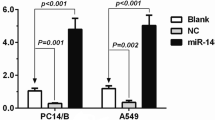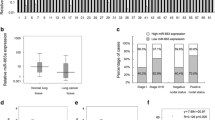Abstract
Background
Development of efficient therapies of lung cancer and deep understanding of their anti-tumor mechanism are very important. The aim of the present study is to investigate the therapeutic effect of microRNA-22 (miR-22) on lung cancer using in vitro and in vivo methods.
Methods
Expression level of miR-22 in lung cancer specimens and relative normal tissues was detected by microRNA-specific quantitative real-time PCR (Q-PCR). Invasion assay, cell counting kit-8 assay, and Annexin V/7-AAD analysis were performed to test the invasion and proliferation of lung cancer cell after transfection. The effect of miR-22 on lung cancer in vivo was validated by murine xenograft model.
Results
Q-PCR detection of miR-22 in clinical samples showed that the relative expression level of miR-22 in lung cancer tissues and lung cancer cell lines was lower than that in normal tissues. Transfection of miR-22 expression plasmids could significantly inhibit the increased cell numbers and invasion of A549 and H1299 lung cancer cell lines. Furthermore, miR-22 was demonstrated to inhibit the expression of ErbB3 through post-transcriptional regulation via binding to ErbB3 3’-UTR. Co-transfection of ErbB3 expression plasmid could promote the proliferation and invasion of A549 and H1299. In vivo experiments using nude mice demonstrated that over-expression of miR-22 could significantly decrease the volume and weight of tumors.
Conclusions
miR-22 exhibited excellent anti-lung cancer activity in vitro and in vivo, and post-transcriptional regulation of ErbB3 might be a potential mechanism.





Similar content being viewed by others
References
Bar N, Dikstein R (2010) miR-22 foms a regulatory loop in PTEN/AKT pathway and modulates signaling kinetics. PLoS One 5:e10859
Bartel DP (2009) MicroRNAs: target recognition and regulatory functions. Cell 136:215–233
Carthew RW, Sontheimer EJ (2009) Origins and mechanisms of miRNAs and siRNAs. Cell 136:642–655
Engelman JA, Janne PA, Mermel C, Pearlberg J, Mukohara T, Fleet C, Cichowski K, Johnson BE, Cantley LC (2005) ErbB3 mediates phosphoinositide 3-kinase activity in gefitinib-sensitive non-small cell lung cancer cell lines. Proc Natl Acad Sci USA 102:3788–3793
Filipowicz W, Bhattacharyya SN, Sonenberg N (2008) Mechanisms of post-transcriptional regulation by microRNAs: are the answers in sight? Nat Rev Genet 9:102–114
Holbro T, Beerli RR, Maurer F, Koziczak M, Barbas CF, Hynes NE (2003) The ErbB2/ErbB3 heterodimer functions as an oncogenic unit: ErbB2 requires ErbB3 to drive breast tumor cell proliferation. Proc Natl Acad Sci USA 100:8933–8938
Jemal A, Bray F, Center MM, Felay J, Ward E, Forman D (2011) Global cancer statistics. CA Cancer J Clin 61:69–90
Kim VN, Han J, Siomi MC (2009) Biogenesis of small RNAs in animals. Nat Rev Mol Cell Biol 10:126–139
Laskin JJ, Sandler AB (2005) State of the art in therapy for non-small cell lung cancer. Cancer Invest 23:427–442
Pandey DP, Picard D (2009) miR-22 inhibits estrogen signaling by directly targeting the estrogen receptor alpha mRNA. Mol Cell Biol 29:3783–3790
Schoeberl B, Faber AC, Li D, Liang MC, Crosby K, Onsum M, Burenkova O, Pace E, Walton Z, Nie L, Fulgham A, Song Y, Nielsen UB, Engelman JA, Wong KK (2010) An ErbB3 antibody, MM-121, is active in cancers with ligand-dependent activation. Cancer Res 2010(70):2485–2494
Sheng Q, Liu X, Fleming E, Yuan K, Piao H, Chen J, Moustafa Z, Thomas RK, Greulich H, Schinzel A, Zaghlul S, Batt D, Ettenberg S, Meyerson M, Schoeberl B, Kung AL, Hahn WC, Drapkin R, Livingston DM, Liu JF (2010) An activated ErbB3/NRG1 autocrine loop supports in vivo proliferation in ovarian cancer cells. Cancer Cell 17:298–310
Wang H, Wu J, Meng X, Ying X, Zuo Y, Liu R, Pan Z, Kang T, Huang W (2011) MicroRNA-342 inhibits colorectal cancer cell proliferation and invasion by directly targeting DNA methyltransferase 1. Carcinogenesis 32:1033–1042
Xiong J, Yu D, Wei N, Fu H, Cai T, Huang Y, Wu C, Zheng X, Du Q, Lin D, Liang Z (2010a) An estrogen receptor alpha suppressor, microRNA-22, is downregulated in estrogen receptor alpha-positive human breast cancer cell lines and clinical samples. FEBS J 277:1684–1694
Xiong J, Du Q, Liang Z (2010b) Tumor-suppressive microRNA-22 inhibits the transcription of E-box-containing c-Myc target genes by silencing c-Myc binding protein. Oncogene 29:4980–4988
Xu D, Takeshita F, Hino Y, Fukunaga S, Kudo Y, Tamaki A, Matsunaga J, Takahashi R, Takata T, Shimamoto A, Ochiya T, Tahara H (2011) miR-22 represses cancer progression by inducing cellular senescence. J Cell Biol 193:409–424
Yamakuchi M, Yagi S, Ito T, Lowenstein CJ (2011) MicroRNA-22 regulates hypoxia signaling in colon cancer cells. PLoS One 6:e20291
Zhang J, Yang Y, Yang T, Liu Y, Li A, Fu S, Wu M, Pan Z, Zhou W (2010) microRNA-22, downregulated in heptocellular carcinoma and correlated with prognosis, suppresses cell proliferation and tumourigenicity. Br J Cancer 103:1215–1220
Conflict of interest
The authors declare no conflict of interest.
Author information
Authors and Affiliations
Corresponding author
Electronic supplementary material
Below is the link to the electronic supplementary material.
Rights and permissions
About this article
Cite this article
Ling, B., Wang, GX., Long, G. et al. Tumor suppressor miR-22 suppresses lung cancer cell progression through post-transcriptional regulation of ErbB3. J Cancer Res Clin Oncol 138, 1355–1361 (2012). https://doi.org/10.1007/s00432-012-1194-2
Received:
Accepted:
Published:
Issue Date:
DOI: https://doi.org/10.1007/s00432-012-1194-2




